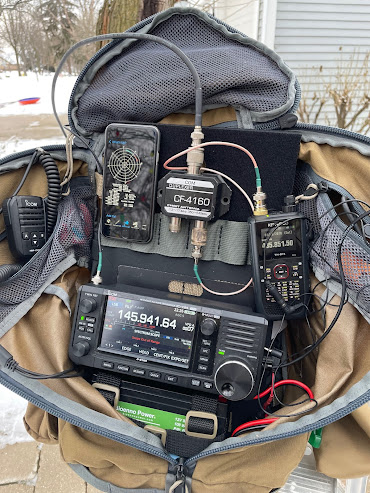Winter Field Day: The Nearly Universal Radio Carrier Revisited
Executive Summary:
Yeah, I promised we'd finished beating this radio carrier dead horse.
Don't despair, the next entry will be a pretty slick little equitorial tracking head for your satellite antenna that works on the very light and hikeable Buddy Stick Pro tripod. Or many other things.
But today it's radio carrier again. I'll keep it short and share a just a few words about how the carrier worked for Winter Field Day.
Bottom line: The carrier worked really well, everything else, not so much.
WFD
I'll be honest. I don't operate Winter Field Day to score points. It's cold. But every year I use it to stress test whatever portable ops projects I've developed over the year. If it works in winter, it's probably good to go. A possible exception is hot, rainy weather, but let's leave that for next month at ZF.
The carrier was tested a lot this summer and performed as it should. But for this winter, I wanted to backpack a station for HF, VHF and UHF, including antennas. And including satellite capability.
Adding satellite functionality meant using an all-band shack-in-a-box rig, adding a downlink receiver, a diplexer to use as a Mode J filter, and some sort of satellite tracking visual indicator. We'll talk antennas in the next post.
Here's what I came up with.
The existing carrier was a good start.
The PALS webbing accommodated a new battery sling at the bottom of the carrier for the 9 aH Bioenno, the shelf with the IC-705 and the TH-74D handie-talkie downlink receiver.
I still needed to securely mount the old iPhone that had been retasked for running the SATTRACK program, and the diplexer/Mode J filter.
The solution for this was easier than I thought. If you remember there was nothing on the carrier board above the original radio shelf. I had some left over loop material and covered the top third of the carrier with it. It was then a simple matter to add some hook material to the back of an old phone case, and the diplexer case, and just stick 'em where I needed 'em.
In hindsight, it's obvious that the original carrier should have included a loop material field for stickable gear and pouches.
Rev.2 will probably be built by covering the entire board with loop material, and then sewing the PALS webbing over that base. That way, I will have a big loop field at the top of the carrier, just in case, and alternating rows of loop material between the rows of PALS everywhere else.
Ever onward.
So first day out I made a couple of V/U and U/V satellite Q's. And the bag carried very well with no shifting of contents. Proof of concept. Check. Receive quality was good, transmit quality reported as good. Special thanks to a very patient KF2T for the first Mode J QSO out in the wild.
But operating wasn't pretty. To tune the TH-74D downlink receiver, you need to rotate a ring that is concentric with the volume control. Not easy when mounted to the board. Also, the degree of difficulty with 20 degree F temp is increased. Alot.
Flip top mittens that let you uncover your fingertips are generally great for winter operation, but your fingertips - the only parts that matter for grabbing tiny concentric HT knobs - still get numb. This causes you to sometimes move both rings, causing the volume to go up and down at inopportune times. (no pun intended there - inoperTUNE....I crack myself up - sorry 🙊) And reaching deep into the pack did not make tuning any easier. So there will be a bit of reworking to the HT position.
But the carrier was up to the task. The loop field mod, performed with strong double-sided carpet tape, took all of 15 minutes. Another 10 to add hook material to the phone case and diplexer, and it was off to the races.
Still liking the carrier idea. 😎 But I'm reminded that there's more to this than finding solid, stable attachment points for an integrated set of equipment like the satellite station. You still need to make sure that the equipment is easy to use under field conditions. I think they call that ergonomics. ( Ergonomics- the science of end users educating designers - we've all been there - on both sides).
So if I want that small downlink receiver to work, it will need to be relocated, or perhaps remotely tuned with a hand mic. Or tuned with something better, like maybe an encoder with a knob that plugs into the hand mic jack and fits on your wrist? Any TH-74 folks have any good ideas?




Comments